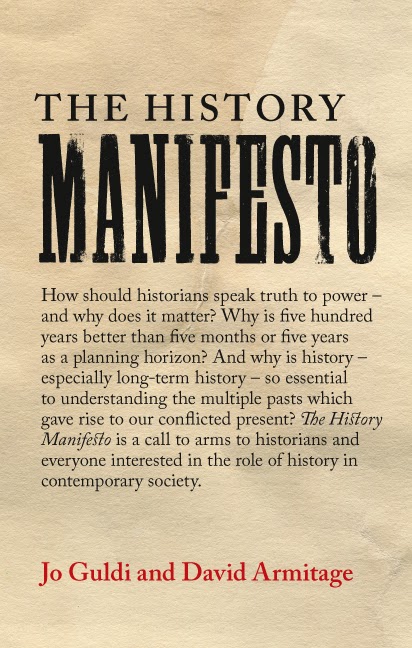Two years ago, a friend of mine forwarded me a link to a book whose title and very premise she knew I would find compelling: The History Manifesto.
I ordered the book, and upon reception proceeded to devour it. “Finally“, I thought to myself, “a good introduction to the field of academic history and a spirited defense of the profession, in response to the charge of historians’ alleged irrelevance towards present-day social issues and problems”.
 I read through the introductory chapter. Sure enough, it began with an indictment of the blind spots of our current political and economic elites, unable to think through humanity’s most pressing issues outside of the scope of the short term. According to Jo Guldi and David Armitage, co-authors of the History Manifesto, present-day humanity is chronically addicted to short-termism. And historians, of all people, are uniquely positioned to offer real guidance beyond our narrow-band consciousness, or “presentism”.
I read through the introductory chapter. Sure enough, it began with an indictment of the blind spots of our current political and economic elites, unable to think through humanity’s most pressing issues outside of the scope of the short term. According to Jo Guldi and David Armitage, co-authors of the History Manifesto, present-day humanity is chronically addicted to short-termism. And historians, of all people, are uniquely positioned to offer real guidance beyond our narrow-band consciousness, or “presentism”.
So far, so good.
As I read on, however, I became increasingly skeptical of the types of arguments Guldi and Armitage’s were making to promote their profession. First, the problems they identified as needing long-term analysis were construed using the vocabulary of international elite bodies : climate change, governance, and global inequality. These are pressing issues to be sure, but the Manifesto’s blanket acquiescence of the concepts that underpin these issues seemed like a missed occasion for debate. Second, following their assessment of today’s Big Issues, the authors seemed to promote the idea that historians should sit with economists around the Prince’s table, i.e. as policy advisors active in government. In other words, Guldi and Armitage’s anti-establishment posture did not jive with the tone of the writing, the vocabulary employed, or the overarching argument contained in the Manifesto.
A third point that caused me to be taken aback, was the Manifesto’s unabashed promotion of new methods and tools that embrace the Big Data paradigm. The Manifesto’s presentation of the different schools of twentieth-century historical research – from Annales historians, to cliometrics, to micro-history – neatly dovetailed into a “pitch” of sorts, demonstrating how the latest quantification tools could be used for analyzing large historical data sets, useful for predictive policy-making. Relevancy being their clarion call, I could see how easy it was for Guldi and Armitage to confuse historical methods with computation tools. And in this way, the authors of the History Manifesto missed a second major occasion to engage critically with the assumptions of our times, namely, the regime of Big Data.
The Big Data Zeitgeist
How to respond to these missed opportunities? I first had to put my finger on what had insidiously crept into the mind-set of our stalwart academic historians. And so I devised of an article series on Play the Past, a blog I regularly contribute to, that would address Big Data not as a set of tools, but as a “technological environment”. In other words, may aim was to probe the unspoken assumptions of the current day quantification craze in academic research – and in cutting-edge management and “governance” jargon, and techniques – to help show a way out of the “short-termism” identified by Guldi and Armitage, but from a true humanities perspective.
 Specifically, I proposed to look at the quantification mania that has taken the humanities by storm – witness the “digital humanities” – in order to draw a line in the sand between social science methodologies and the humanist tradition (or at least, its remnants in academia). I wanted to deploy the tools of literary criticism to “probe” social science, and show quantification as a way of looking at the world – “Seeing Like a State”, as James C. Scott put it in his landmark study of administrative technique. Without knowing it, I was doing the same thing Marshall McLuhan did in his freewheeling research back in the 1950s, 60s and 70s, trying to understand a given technology as a “total environment”, unperceived by its users, and shaping their perceptions of the world and themselves in ways unknown to them.
Specifically, I proposed to look at the quantification mania that has taken the humanities by storm – witness the “digital humanities” – in order to draw a line in the sand between social science methodologies and the humanist tradition (or at least, its remnants in academia). I wanted to deploy the tools of literary criticism to “probe” social science, and show quantification as a way of looking at the world – “Seeing Like a State”, as James C. Scott put it in his landmark study of administrative technique. Without knowing it, I was doing the same thing Marshall McLuhan did in his freewheeling research back in the 1950s, 60s and 70s, trying to understand a given technology as a “total environment”, unperceived by its users, and shaping their perceptions of the world and themselves in ways unknown to them.
Thus, to properly counter the hidden assumptions of the History Manifesto, I needed to expose one of its main “selling point”, namely, Big Data as a proposed solution to our short-term narrow view. And video games, of all things, would be my main vehicle for this critical exploration, to help me highlight our irrepressible habit of transforming energy and information patterns into stories, and demonstrate the ultimate “End Game” of quantification.
Why video games? In the process of writing this series for Play the Past, I stumbled upon the “ground zero” of all historical writing, i.e. what makes something “historical” to begin with: human survival, and the memory and lessons of difficult ordeals passed down the generations, as a shaping force of human culture and collective wisdom. And I thought to myself: is there a connection between the plight of human survival and our current drowning in data? Does the obsessive rehearsal of the survival scene in video games reveal some primordial storytelling impulse embedded in the data-scape, as a high-tech extension of human capability?
Am I beginning to lose you yet? 😛
Video Games: Avatars and Play Spaces
The answer to my puzzle would come from unexpected quarters: video game theory. By examining key features of video games, as they appear in different game genres, I was able to bridge the gap between the social sciences methodologies that inform Big Data, and the new forms of storytelling that computer software enable.
 So, how has storytelling changed with video games? For one, video games are hand-coded computer software that provide fictional play spaces or story spaces for players to explore. Or, virtual worlds rendered by a calculating machine, that bound the user in a set of possible interactions enabled by coded instructions. If video games are “interactive” and allow for player “choice”, those choices are strictly defined by the computer program in all their possible expressions, excepting software bugs.
So, how has storytelling changed with video games? For one, video games are hand-coded computer software that provide fictional play spaces or story spaces for players to explore. Or, virtual worlds rendered by a calculating machine, that bound the user in a set of possible interactions enabled by coded instructions. If video games are “interactive” and allow for player “choice”, those choices are strictly defined by the computer program in all their possible expressions, excepting software bugs.
This abstract, programmatic quality of a given player’s capacity to interact with the virtual world has implications for characterization and storytelling in video games. Firstly, as far as game characters go, player-controllable avatars are akin to puppets, with predefined control parameters (depending on the game genre), through which players interact with the virtual environment in various ludic ways. This type of interaction is cybernetic, a man-machine hybrid. Secondly, as far as storytelling goes, game environments are virtual spaces that the player-avatar traverses in the act of exploration, or achieving goals as defined by the game rules and objectives. If traditional storytelling has a temporal bias, video games have a spatial bias.
Finally, individual games are defined by their gameplay loops, the specific set of actions the player must repeatedly and incrementally engage in to master the rules, and progress in the game. By virtue of being software and rule-sets, they also allow players to restart the game, or parts of the game, and replay a given game interval : so-called game replayability.
Thus, even if game stories are told in the traditional narrative, expository or dramatic manner used in movies or books, video games’ replayability and their spatial bias allow for more emergent, and recursive forms of storytelling. Rinse, repeat, tweak, rinse, repeat, tweak, alternate ending. This quality of video games predisposes them to a form of storytelling that is focused on experimental scenarios. Same setting, different possible outcomes.
 Now, if you’re a gamer, you know that there is bewildering variety of themes and game experiences available in the marketplace. For many years already, the game industry has surpassed the movie industry in terms of worldwide gross revenue – in the billions. With digital distribution and mobile games on the rise, and the “indie” movement competing alongside the Big Studios in the console and PC space, the video game market is currently saturated. And there is no sign that this trend is abating any time soon.
Now, if you’re a gamer, you know that there is bewildering variety of themes and game experiences available in the marketplace. For many years already, the game industry has surpassed the movie industry in terms of worldwide gross revenue – in the billions. With digital distribution and mobile games on the rise, and the “indie” movement competing alongside the Big Studios in the console and PC space, the video game market is currently saturated. And there is no sign that this trend is abating any time soon.
Peel away this veneer of plenty though, and you’ll notice certain popular themes that keep coming back over and over again, and that cut across game genres. I’ve argued so far that the computer support of games pushes game and narrative design in certain directions. So if we’ve analyzed video games correctly, it should be no surprise that themes of war, exploration, conquest, management and fantasy role play are perennial favorites in the market.
My point is that these genres and themes aren’t just popular because of market demand. They’re also a natural fit with the medium that supports them. And the single core narrative premise they all have in common is survival. Survival… against enemies, or against difficult odds, or against Great Evil. Stripped of their story paint coatings, the premises of most video games are simple: beat the game, or it beats you.
Survival games and ideal-types
The core argument of my Big Data series then, is that the popularity of the survival theme in video games can be attributed to a structural feature of video games: the experimental play space as dominant mode of storytelling. Why “survival”? Simply put: to make sheer repetition interesting – if not fascinating – game designers must ensure that the narrative stakes of their games are high, i.e. if the player’s character/avatar doesn’t do such and such action properly, he or she “dies”.
Because of the nature of computer software, these tightly scoped and repetitive “stories” (gameplay loops) of survival in video games also take on an abstracted quality. The player’s avatar, as I have already pointed out, shares this peculiar quality, being composed of a set of control inputs, game mechanics (rules and actions) and data attributes. At the systemic level, the cybernetic relation between, player, avatar and play space “absorb” the player’s individuality into the programmatic elements of the game. And the survival theme so popular in video games also betrays the peculiar “narrative bias” of computer software : on, off, do, die, try, fail.

At a higher level, I argue that the (re)playable fictional scenarios of video games designed around the zero-sum principles of “survival simulation” facilitate the emergence of an abstracted, “collective actor”: the survivor, or archetypal storyteller. In social science parlance, collective actors are called “ideal-types“.
And there’s your link between storytelling, survival games and social science methodology. Thanks to the structural features of video games – abstraction, feedback loops and the ethics of experiment – we can now begin to see how the storytelling urge is also carried forth in the social sciences approach to human behavior. For example, Big Data aggregates every individual’s “data points” into huge data sets, for complex multivariate analysis. But it is the uses that data are put to that is relevant to any self-respecting social engineer or Quantified Selfer, the ways data “reflects back” into the real world, and shape individual and aggregate user behavior in return.
Input, process, feedback, adapt. Rinse, repeat, retry, survive. And report to the Hive Mind.
My point is that the interplay of complex and unwieldy data sets in data analysis software are analogous to the interlocking of game mechanics in video games. Thus, the tightly-bound experimental play space of the video game is the best place to see how stories can emerge from abstracted actors – ideal-types – composed of discrete data sets (i.e. “character attributes”). And the survival theme adds the particular focus on testing variant scenarios of success and failure: the pared down elements of storytelling.
The Survivor as Archetype

I will let the reader interested in parsing out my demonstration, follow up with the article series on Play the Past. Suffice it to say that the writing of this series posed quite a challenge for me. First, I had to analyze the writing of two professional historians whose work I admire, but whose basic stance on the profession of the historian in the History Manifesto seemed to tip the scales of the humanities/social science balance squarely in favor of the social sciences. Second, I had to assess the theoretical limitation of the social sciences, as they are harnessed by Big Data. Third, I needed to probe the issue of “storytelling with data” creatively, with examples from a medium that is at the cutting edge of technology and cultural expression: video games.
The three video games I analyzed for my purposes, thankfully, were beautifully designed, and provided hours of engrossing gameplay. Each of them opened avenues of investigation that I am just beginning to map. And in reading these articles, I am hoping that you too may also find that sweet spot between the critical examination of ideas and the exploration of that basic human conundrum, found in every age, and culture: making order from chaos, and finding meaning in the face of oblivion.


Leave a Reply